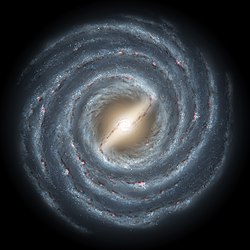Ursa-Major-I-Zwerggalaxie
| Galaxie Ursa-Major-I-Zwerggalaxie | |
|---|---|
| AladinLite | |
| Sternbild | Großer Bär |
| Position Äquinoktium: J2000.0, Epoche: J2000.0 | |
| Rektaszension | 10h 34m 52,8s[1] |
| Deklination | 51° 55′ 12″ [1] |
| Erscheinungsbild | |
| Morphologischer Typ | dSph [1] |
| Winkelausdehnung | 23′ × 12′ [2] |
| Physikalische Daten | |
| Zugehörigkeit | Lokale Gruppe |
| Rotverschiebung | 3,67 · 10−3 [1] |
| Radialgeschwindigkeit | (1101 ± 1) km/s [1] |
| Entfernung | (330.000 ± 10.000) Lj / (100.000 ± 3.000) pc [1] |
| Absolute Helligkeit | −6,75 V mag [2] |
| Geschichte | |
| Entdeckung | Beth Willman et al.[2] |
| Entdeckungsdatum | 2005[2] |
| Katalogbezeichnungen | |
Die Ursa-Major-I-Zwerggalaxie (kurz auch UMa I) ist eine spheroidale Zwerggalaxie und Satellitengalaxie der Milchstraße im Sternbild des Großen Bären. Die Entdeckung der Galaxie durch Beth Willman et al. wurde im Jahr 2005 verkündet[2].
Eigenschaften
Selbst unter den Zwerggalaxien ist die UMa I noch relativ klein mit ihrer nur wenige Tausend Lichtjahren messenden Durchmesser. Stand 2006 war sie die drittlichtschwächste Galaxie überhaupt (lässt man die sogenannten dunklen Galaxien außer Acht wie z. B. VirgoHI21 im Virgo-Galaxienhaufen), gemessen an ihrer absoluten Helligkeit.
| Zwerggalaxie | MV |
|---|---|
| Ursa-Major-II-Zwerggalaxie | −3,8m |
| Bootes-I-Zwerggalaxie | −5,7m |
| Ursa-Major-I-Zwerggalaxie | −6,75m[2] |
D. h., sie ist als Galaxie lichtschwächer als mancher Einzelstern in der Milchstraße wie beispielsweise Deneb und in etwa in der Leuchtkraft vergleichbar mit Rigel. Sie weist einige Ähnlichkeiten mit der Sextans-Zwerggalaxie auf[2]. Beide Galaxien sind sehr alt und metallarm.
Die Ursa-Major-I-Zwerggalaxie liegt in einer Entfernung von etwa 3,30 × 105 Lichtjahren was ungefähr der doppelten Entfernung zur Großen Magellanschen Wolke entspricht.
Besonderes
Ein anderes astronomisches Objekt von Edwin Hubble bereits 1949 entdeckt, wurde ebenfalls als Ursa-Major-Zwerggalaxie bezeichnet.[3] Es wurde dann später als Palomar 4 bezeichnet. Aufgrund seines sonderbaren Aussehens wurde es zunächst als Zwerggalaxie klassifiziert. Tatsächlich ist Palomar 4 mit einer Entfernung von etwa 3,6 × 105 Lichtjahren der am weitesten bekannte, entfernte Kugelsternhaufen unserer Milchstraße.
Weiteres
- Liste der Satellitengalaxien der Milchstraße
- Liste der Galaxien der Lokalen Gruppe
Einzelnachweise
- ↑ a b c d NASA/IPAC EXTRAGALACTIC DATABASE
- ↑ a b c d e f g Willman, Dalcanton, Martinez-Delgado, et al. (2005) "A New Milky Way Dwarf Galaxy in Ursa Major", submitted to Astrophysical Journal Letters, on arXiv.org: astro-ph/0503552
- ↑ Ursa Major Dwarf, Palomar 4. In: Milky Way Globular Clusters. Abgerufen am 16. April 2005.
Weblinks
Auf dieser Seite verwendete Medien
Caption from NASA: Like early explorers mapping the continents of our globe, astronomers are busy charting the spiral structure of our galaxy, the Milky Way. Using infrared images from NASA's Spitzer Space Telescope, scientists have discovered that the Milky Way's elegant spiral structure is dominated by just two arms wrapping off the ends of a central bar of stars. Previously, our galaxy was thought to possess four major arms.
This artist's concept illustrates the new view of the Milky Way, along with other findings presented at the 212th American Astronomical Society meeting in St. Louis, Mo. The galaxy's two major arms (Scutum-Centaurus and Perseus) can be seen attached to the ends of a thick central bar, while the two now-demoted minor arms (Norma and Sagittarius) are less distinct and located between the major arms. The major arms consist of the highest densities of both young and old stars; the minor arms are primarily filled with gas and pockets of star-forming activity.
The artist's concept also includes a new spiral arm, called the "Far-3 kiloparsec arm," discovered via a radio-telescope survey of gas in the Milky Way. This arm is shorter than the two major arms and lies along the bar of the galaxy.
Our sun lies near a small, partial arm called the Orion Arm, or Orion Spur, located between the Sagittarius and Perseus arms.



